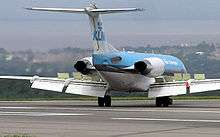Air brake (aeronautics)
In aeronautics, air brakes or speed brakes are a type of flight control surfaces used on an aircraft to increase drag or increase the angle of approach during landing. Air brakes differ from spoilers in that air brakes are designed to increase drag while making little change to lift, whereas spoilers reduce the lift-to-drag ratio and require a higher angle of attack to maintain lift, resulting in a higher stall speed.[1]
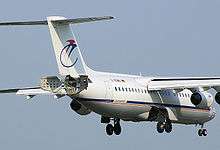
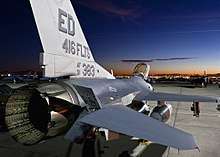
The earliest known air brake was developed in 1931 and deployed on the wing support struts.[2] Not long after, air brakes located on the bottom of the wing's trailing edge were developed and became the standard type of aircraft air brake for decades.
In 1936, Hans Jacobs, who headed Nazi Germany's Deutsche Forschungsanstalt für Segelflug (DFS) glider research organization before World War II, developed blade-style self-operating dive brakes, on the upper and lower surface of each wing, for gliders.[3] Most early gliders were equipped with spoilers on the wings in order to adjust their angle of descent during approach to landing. More modern gliders use air brakes which may spoil lift as well as increase drag, dependent on where they are positioned.

Often, characteristics of both spoilers and air brakes are desirable and are combined - most modern airliner jets feature combined spoiler and air brake controls. On landing, the deployment of these spoilers ("lift dumpers") causes a dramatic loss of lift and hence the weight of the aircraft is transferred from the wings to the undercarriage, allowing the wheels to be mechanically braked with much less chance of skidding. In addition, the form drag created by the spoilers directly assists the braking effect. Reverse thrust is also used to help slow the aircraft after landing.[4]
Virtually all jet powered aircraft have an air brake or, in the case of most airliners, lift spoilers that also act as air brakes. Propeller driven aircraft benefit from the natural braking effect of the propeller when the engine is throttled back, but jet powered aircraft have no such innate braking effect and must use air brakes to control descent speed. Many early jets used parachutes as air brakes on approach (Arado Ar 234, Boeing B-47) or after landing (English Electric Lightning).
The Blackburn Buccaneer naval strike aircraft designed in the 1950s had a tail cone that was split and could be hydraulically opened to the sides to act as a variable air brake. It also helped to reduce the length of the aircraft in the confined space on an aircraft carrier.
The F-15 Eagle, Sukhoi Su-27, F-18 Hornet and other fighters have an air brake located just behind the cockpit.

Introduction
An air brake is a panel conforming the shape of an aircraft that can be opened with hydraulic pressure in order to create drag, similar to spoilers which are on the edges of the aircraft wings and open in an upward position forcing the plane towards the ground.[5] Air brakes are used when the aircraft needs to reduce its airspeed, while spoilers are only able to be opened when the airplane is approaching the runway and about to touch down. Lift dumpers, a type of air brake, are mounted on the top of a fuselage. When the panel is opened, it acts as a small spoiler, gently pushing the aircraft down. Flaps also increase drag and decrease airspeed, but are primarily for reducing the stall speed, allowing the aircraft to land at a slower speed.[6]
History
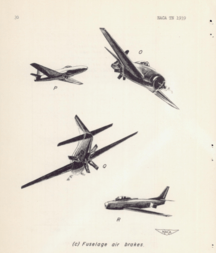
Following the invention of powered flight, and the rapid development of fixed-wing aircraft in the early 20th century, designers endeavoured for several decades to make airplanes faster than before. A universal goal for all manufacturers for some time, was to reach the speed of sound (supersonic speed), approximately 740 miles per hour (mph). Apart from the challenge of developing an engine capable of producing such a speed, and preventing the aircraft from breaking apart under the stress, one major concern was how to keep the aircraft in stable flight and then return it to a normal flying speed using a stronger braking system.
In the 1930s, air brake systems were still using simple flaps that were manually controlled by a lever in the cockpit, with mechanical devices running through the wings. However, in order for the air brakes to be effective at 740 mph, they needed to be mounted on the fuselage for improved wing control, and operated through some form of dampener or hydraulic system, allowing the pilot to physically pull a lever in order to create an excessive amount of air resistance.[7]
The concept of fuselage-mounted air brakes, or speed brakes, spread throughout the 1930s, eventually becoming more commonplace in the 1940s. In the 1930s, pilots would land with the nose of the plane tilted upwards at a 45-degree angle for short landings in order to effect rapid deceleration. With this method, "the drag or resistance is increased by 300 percent, and the distance required to land is cut down to one third of the usual stopping distance".[8] However, there was an urgent need to develop an alternate way of drastically reducing speed on landing that would not cause the pilot to lose sight of what was ahead of him. This led to the development of a new air braking system with additional flaps, mounted on the wing, that opened in two directions simultaneously. This wing-mounted design allowed the effective surface area of the flaps to be increased by 100 percent for landing, producing substantially more drag than the conceptual fuselage design and resulting in a sharper reduction in air speed. This meant that the pilot was able to see the landing strip in front of the aircraft as there was no longer the need to tilt the nose upwards at a steep angle at close to stalling speeds.[4]
The rate of deceleration and foot pounds of force applied to each brake is dependent upon where the brake is located. Upper and lower surface flaps positioned along the wings provide the steadiest braking curve (comparing force applied against deceleration rate), but the flaps are subjected to greater stresses at theoretically higher speeds. Spoilers on the wings experience less force, but cannot slow down the aircraft at higher speeds. Brake plates mounted on the fuselage of an aircraft experience much more force applied per square inch but they can also reduce the speed of the aircraft far more effectively at higher speeds when used with some form of wing-mounted assisting brake. With the use of panels mounted along the body of the plane, the brake plates themselves can be made thicker to withstand the greater amount of force applied to them.[9] In theory, air brakes are increasingly less useful at very high altitudes because simply creating more surface area on the aircraft does not create sufficient air resistance due to the thinning of the Earth's atmosphere at such altitudes. According to their technology, the drag coefficient for a vertical dive at 40,000 feet or above is too much for a simple air brake to handle.[9]
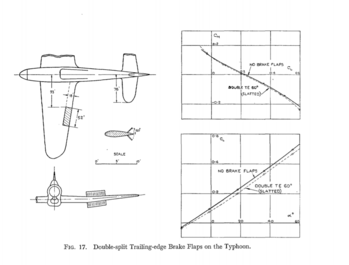
Before the 1950s, British researchers found that different drag patterns were produced by altering the shape of the air brakes and flaps being tested. The use of two flaps per wing on military fighter aircraft, with one flap opening upwards and the other opening downwards, allows the most rapid deceleration while maintaining accurate control of the plane. Flaps that open upwards create a downforce in addition to reducing air speed, thus forcing the plane towards the ground; conversely, flaps that open downwards create an upforce which pushes the nose of the aircraft into the air. Wing-mounted air brakes that open in both directions allow the opposing upward and downward forces to cancel each other out, creating resistance that forces the aircraft to decelerate. At the same time, different styles of brake panel were being tested for newer jet aircraft. A flat-plat panel would provide the most air resistance, thus reducing the air speed more effectively, but the huge amount of stress on the panel made it unsuitable at the time for high speed flights. With the excessive speeds produced by a jet aircraft, these forces could be too much for the brakes to handle. Additionally, with no air passing through the brake panels, the slightest turbulence or change in air pressure could throw the aircraft off balance. With slotted or perforated brake plates, the distortion in the air flow is greatly reduced, making the aircraft more stable when braking from high speeds, but at the cost of the rate of deceleration.[10] The more open space provided by the plates, the better the control of the aircraft due to the reduced amount of air flow disturbance. There are various different brake plate options for different aircraft, each with their own individual design purpose and usage.
Scientific principles

Principles such as plotting semi-empirical relations in order to estimate aircraft component parasite drag are necessary for developing and understanding the physical properties behind flight. Essentially, everything on the aircraft is taken into consideration for its size, surface area and amount of drag created. Everything from the location and size of the jet engines, to the shape of the fuselage, to wings and winglets and flaps are all noted, and equations are derived to develop an idea on the drag being created. Specifically, on the subject of air brakes and the intentional act of reducing air speed, slotted fowler flaps are examined, and a graph is constructed on the angle degree in which the flaps are tilted and the amount of lift and drag created by the distortion in the direction of air flow. Additionally, to reduce air speed, "whether in combat or landing, flat plates are used which are attached to the fuselage and shaped to its geometric contour when retracted".[11] In the circumstance of air brakes used during subsonic flight, the equation for drag would be CDπ_brake=1.2-2.0 (with an average of 1.6).[11]
Technology
There are several styles of wing-based flaps and spoilers found on today's aircraft that greatly resemble some of the first air speed brakes invented. Slotted and fowler flaps are "both designed to physically increase the overall surface area of the wing, literally making the wing bigger".[12] In slotted flaps, there at least one open gap or slot in between the actual fixed wind of the aircraft and the adjustable flap. With these types, air passing underneath the wing of the aircraft is allowed to escape up through the slot due to the position of the flap tilting down. This directional flow of air and the extra surface area underneath the wing causes slight downforce pressure as well as reduced airspeed. Spoilers are often used in larger aircraft and used more temporarily and for less amounts of time than typical flaps as they are designed to not only slow the craft down, but it creates downforce pushing the plane towards the ground. Spoilers are essentially an upside-down wing where the length on the bottom of the spoiler exceeds that on the top, resulting in the high air pressure on top of the spoiler to push down towards that of lower air pressure underneath. Lips are also used for the air running across the top of a wing to be forced further up, creating more drag and also pushing the plane closer to the ground. Spoilers on aircraft are only used when landing, not in midair, often with conjunction of slotted flaps. Together the flaps and spoiler disrupt the smooth flow of the wind and force it up and down across different surfaces protruding from or through the wing, causing a large amount of wind resistance and drag reducing overall air speed, acting as an air brake.[12]
Split control surfaces
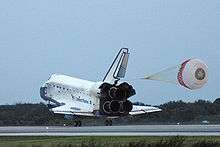
The deceleron is an aileron that functions normally in flight but can split in half such that the top half goes up as the bottom half goes down to brake. This technique was first used on the F-89 Scorpion and has since been used by Northrop on several aircraft, including the B-2 Spirit.
The Space Shuttle used a similar system. The vertically-split rudder opened in "clamshell" fashion on landing to act as a speed brake.[13]
See also
References
- "Speed brake". Britannica. Retrieved 28 December 2019.
- "Air Brakes for Planes Greatly Reduce the Landing Speed". Popular Science. Vol. 122 no. 1. January 1933. p. 18.
- Reitsch, Hanna (April 1997) [1955]. The Sky My Kingdom: Memoirs of the Famous German WWII Test-Pilot (Greenhill Military Paperback). Stackpole Books. p. 108. ISBN 9781853672620.
- "Spoilers And Speedbrakes - SKYbrary Aviation Safety". www.skybrary.aero. Retrieved 2019-12-28.
- "Spoilers And Speedbrakes". www.skybrary.aero. 7 August 2016. Retrieved 28 February 2017.
- "How it Works: Speed brakes". AOPA. Retrieved 28 December 2019.
- Naylor, J. L. (June 1932). "FLYING AS FAST AS SOUND". Scientific American. Vol. 146 no. 6. pp. 336–338. JSTOR 24965946.
- Cleveland, Reginald M. (June 1933). "Fly Fast – Land Slow". Scientific American. Vol. 148 no. 6. pp. 320–321. JSTOR 24968249.
- Stephenson, Jack D. (September 1949). "The Effects of Aerodynamic Brakes Upon the Speed Characteristics of Airplanes" (PDF) (Technical Note). NACA.
- Davies, H.; Kirk, F. N. (June 1942). "A Résumé of Aerodynamic Data on Air Brakes" (PDF) (Technical Report). Ministry of Supply.
- Kundu, Ajoy K.; Price, Mark A.; Riordan, David (2016). Theory and Practice of Aircraft Performance (Aerospace Series). Wiley. ISBN 978-1119074175.
- "Parts of an Airplane" (PDF) (Educational resource). NASA. 2010. Retrieved 28 February 2018.
- "Extract from NSTS Shuttle Reference Manual (1988): Space Shuttle Coordinate System – Vertical Tail". NASA. Retrieved 25 October 2012.
External links
![]()
